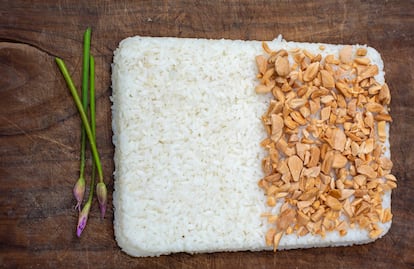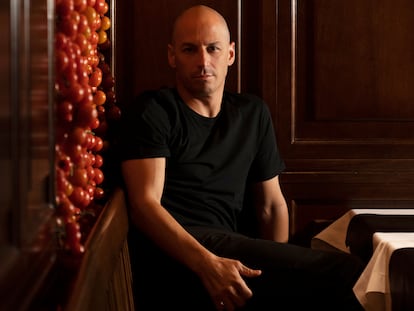Haute cuisine to power the Tour de France cyclists
Dani Lasa, the chef who led R&D at Spain’s celebrated restaurant Mugaritz, embarks on a project that combines molecular cooking with sports nutrition to provide the staggering amounts of energy that elite riders consume in each stage


The cyclists who started the Tour de France on July 1 in Bilbao, Spain are doing a lot of hard work these days. No, we’re not talking about pedaling. It’s eating: Digesting the rice cakes, a staple of their diet on the bike; enduring the monotonous flavors and textures of gels, bars, jellybeans and shakes; and metabolizing 9,000 calories of food a day.
For three weeks, cyclists will pedal four, five, six hours a day, climb mountains, attack and sprint; and only the fittest will make it. It will be hard work, but their bodies—perhaps the most perfect organisms—their muscles, their blood system, their heart, their lungs, are already prepared for this. All of them lead a life of training to make that happen. They are human machines, driven by motors that need to generate almost 2,000 watts in order to produce the average of 450 watts of power they transfer to the pedals on the ascent of the Tourmalet, for example. But those motors need fuel.
“Cycling and life—health—is a matter of energy. The recovery process is a matter of energy, the process of adapting to training is a matter of energy. In everyday life, we are drunk on energy, overfed, and we have to move to expend it. But cycling is the other way around; there’s a need for energy. If you generate 2,000 watts, that means that you spend a tremendous amount of energy on a daily basis, and you have to eat it, that’s no secret,” says Aitor Viribay, the physiologist and nutritionist for Ineos, one of the best teams on the Tour. “You have to eat…a lot. During the hardest stages, [you need to ingest] up to more than 120 grams of carbohydrates per hour, 500 or 600 grams that fill the stomach at the end of the 200 kilometers. And they have to be digested, metabolized and oxidized to be converted into glycogen—muscle fuel—while continuing to pedal. Before that stage, you have to have breakfast, and dinner afterward, and not only [eat] carbohydrates and sugars, but also proteins, and fiber, and even fats. “It’s as simple as that. A cyclist on the Tour may need to ingest up to 5,000 calories in [that] stage and 4,000 more after. And eating 9,000 calories a day is really hard work.”

“Arduous, boring, not at all pleasurable and sometimes even contraindicated” are the sad adjectives Dani Lasa uses to describe sports nutrition for an activity—eating—in which people seek not only nourishment so as not to die but also pleasure.
Dani Lasa, the chef and former director of R&D at Mugaritz, a world-renowned restaurant located in Spain’s northern Basque Country, knows what he’s talking about, and not only because he cooks professionally. He was born in Oiartzun, the Spanish cycling town from which the recently deceased Basque cycling legend Txomin Perurena hailed. Lasa has eaten fried eggs with fried chistorra, a local sausage, at three in the morning at Perurena bar, which is open until dawn. He belongs to a cycling family (his uncles, José Manuel and Miguel Mari, were very good professional riders in the 1970s). Lasa himself was an amateur cyclist; at the age of 48, he is still in great shape and still remembers his unbridled excitement when Spanish cyclist Miguel Indurain ate at Mugaritz. Slim and sinewy, he competes in mountain races. “In my cycling days, I didn’t see anyone who ate enthusiastically. They said, this is a formality, I have to consume calories, I have to consume carbohydrates, I have to consume vitamins, I have to consume amino acids, I have to consume everything, and then I’ll perform. They turned the food into fuel, nothing more. And now… I’ve experienced what it’s like to [consume] a gel with fructose and glucose, to keep taking carbohydrates constantly, and that boredom in my mouth, and I [said] to myself, we could turn this into something more pleasant, or [at least] not so boring, right?

Because of his relationship with the riders, Viribay, a physiologist and nutritionist at Ineos, had the same concern, along with some other ones. He was worried that sports nutrition was not pleasurable at the sensory level, which is an element that helps the cyclist psychologically. He was also concerned about the comfort of the cyclist’s stomach, which affects performance. Poor digestion and diarrhea, an increasingly common occurrence in the peloton, can dash a cyclist’s hopes for good classification. The digestive training that cyclists undergo does not fully solve the problem of discomfort, often caused by the characteristics of the food itself. “There are certain foods that we have understood as suitable and, going a little further into the analysis of their composition, we have seen that they are not,” says the Ineos specialist. “For example, cycling has been using rice cakes for 10 years, but when it cools, rice generates a resistant starch that is not absorbed very well by the body, and it is more of a fiber, a type of fiber. That’s a very positive thing at the level of the [general] population because you go from a more or less simple sugar…to fiber, but it’s not what you need in cycling.”
Cold rice and the need to eliminate fiber from cyclists’ rice cakes brought Viribay and Dani Lasa together through Mikel Zeberio, one of the fathers of Basque gastronomy, at the founding of the From Lab to Field group. It is a cultural and health company, which also includes Juan Carlos Arboleya, a food physicochemist and the director of the master’s degree in Gastronomic Science at the Basque Culinary Center, who also worked at Mugaritz.
Along with Ineos chef James Forsyth, they have embarked on the task of combining sports nutrition with molecular and haute cuisine. “The project’s power resides in what we have always done…: looking—from a very chemical level, on a molecular scale—[at] what texture, what functionality, you can give an ingredient, while always taking the entire culinary aspect into account from the beginning. And that pairing, that tandem, is ready to dive in and start talking to sports nutritionists and physiologists,” says Arboleya. “In sports nutrition, the technological [aspect] always has to go hand in hand with the more cultural and gastronomic part, which yields cuisine. My task of taking a molecule and saying, well, let’s synthesize it this way so that it can be absorbed by the body [to] generate sports performance, would not make [any] sense if the culinary part were not [closely related].”

When Viribay asked Dani Lasa about his issues with starch and rice, he told him that rice was very good for energy through metabolism, but fiber was bad when cycling because it digests poorly. The chef replied, “What do we have to do, Aitor? “And he told me that we had to break up those resistant starches and convert them into mono-, di-, oligosaccharides—simpler chains—instead of complex polysaccharides, so that it could work as a quick gel that the cyclist takes 10 minutes before attacking…In addition, a potato—without starch, of course—would be better than rice,” explains Dani Lasa. He then recalled that over the last 10-15 years at Mugaritz they had already been introduced to fermentation processes that do precisely that.
“When you put cooked potato in your mouth, saliva starts breaking down its starches, which can be amylose, amylopectin, which we’re all familiar with because it is contained in rice, potatoes, sweet potatoes, cassava, in many sources of carbohydrates. Your saliva starts to break them down, you use amylase, glucosidase, in other words, different enzymes…What we do is start breaking them down through cooking processes and exposure to these enzymes, and [we] simplify it.” He started his experimentation with the same clarity of ideas, molecular knowledge and daring with which he began to use gelatin from cod skins to replace butter in emulsions at Mugaritz. He uses the same philosophy with which he has been making kombuchas with grand cru teas for months, which are as highly valued as Burgundy wines, come from exclusive gardens around the world and use the double fermentation technique, which is how champagne is made. “If we manage to reduce kombucha’s acidity, it would be ideal for cyclists, because you can’t continually have acidity going to the stomach or intestine while you’re [cycling],” says Dani Lasa. “Kombucha is made with a scoby, a symbiotic culture colony of bacteria and yeast. And many of them are probiotics. To me, in a way, kombucha illustrates or crystallizes the whole metaphor of the tradition.”
With enzymatic cooking, the starch from the rice and tuber becomes a dough, a raw material with which to prepare the dish, a haute cuisine rice cake that the cyclist can carry in a jersey pocket that won’t spoil at any temperature. “We incorporate crunchy ingredients to make them more fun to eat, and in the crunchy part, you can add seeds, nuts like almonds, or other ingredients that also enrich it with fats, proteins, amino acids, [much like] a potato,” explains Dani Lasa. “We get a raw material that’s much more metabolically accessible, but to me, as a cook, [it’s] a raw material to start cooking, and to arrange or incorporate the flavors we want, [like] sesame or even protein flavors.”
In cycling today, performance is all about eating very well on the bike and eating the right foods. At Ineos, they have a comfort scale and certain markers—such as expired hydrogen fermentation—that reveal malabsorption. No alarm has gone off. In the morning, rivals see that they are so happy that they approach Viribay and ask him: what is your secret?
Sign up for our weekly newsletter to get more English-language news coverage from EL PAÍS USA Edition
Tu suscripción se está usando en otro dispositivo
¿Quieres añadir otro usuario a tu suscripción?
Si continúas leyendo en este dispositivo, no se podrá leer en el otro.
FlechaTu suscripción se está usando en otro dispositivo y solo puedes acceder a EL PAÍS desde un dispositivo a la vez.
Si quieres compartir tu cuenta, cambia tu suscripción a la modalidad Premium, así podrás añadir otro usuario. Cada uno accederá con su propia cuenta de email, lo que os permitirá personalizar vuestra experiencia en EL PAÍS.
¿Tienes una suscripción de empresa? Accede aquí para contratar más cuentas.
En el caso de no saber quién está usando tu cuenta, te recomendamos cambiar tu contraseña aquí.
Si decides continuar compartiendo tu cuenta, este mensaje se mostrará en tu dispositivo y en el de la otra persona que está usando tu cuenta de forma indefinida, afectando a tu experiencia de lectura. Puedes consultar aquí los términos y condiciones de la suscripción digital.
More information
Archived In
Últimas noticias
Welcome to the post-religion era: The idea of Christianity as the absolute truth has become obsolete
‘I thought you would like it’: The risky sexual practice popularized by TV shows and TikTok
The digitalization of tourism: ‘They promise experiences and gave us the worst possible one’
Mexican peso defies uncertainty with forecasts of a new period of stability in 2026
Most viewed
- Sinaloa Cartel war is taking its toll on Los Chapitos
- Reinhard Genzel, Nobel laureate in physics: ‘One-minute videos will never give you the truth’
- Oona Chaplin: ‘I told James Cameron that I was living in a treehouse and starting a permaculture project with a friend’
- Why the price of coffee has skyrocketed: from Brazilian plantations to specialty coffee houses
- Silver prices are going crazy: This is what’s fueling the rally









































